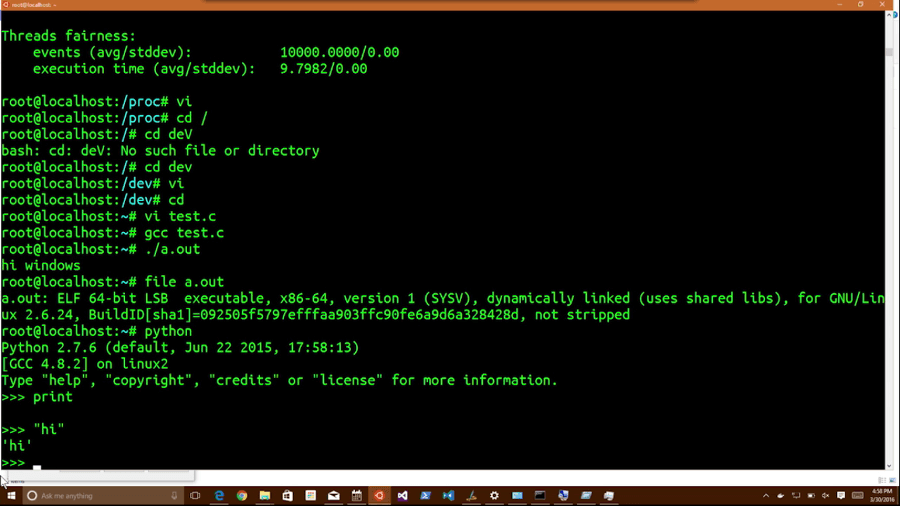Sysbench For Windows
- Sysbench Windows 安装
- Sysbench Windows Binary
- Sysbench For Windows Firewall
- Sysbench For Windows 7
- Sysbench For Windows
In this post I’ll look at some of our recent work for benchmark enthusiasts: a TPCC-like workload for Sysbench (version 1.0 or later).
3.In the sysbench directory, execute cmake -G 'Visual Studio 9 2008' 4.Open sysbench.sln in Explorer and build Relwithdebinfo target. Alternatively, from the command line, issue vcbuild /useenv sysbench.sln 'Relwithdebinfo Win32' I already had Microsoft Visual Studio 2010 Express Edition installed on my Windows 7 machine. Sysbench is a system performance benchmark that includes an OnLine Transaction Processing (OLTP) test profile. The OLTP test is not an approximation of an OLTP test, but is rather a true database-backed benchmark that conducts transactional queries to an instance of MySQL in a CentOS environment. Windows Virtual Desktop The best virtual desktop experience, delivered on Azure Azure SQL Modern SQL family for migration and app modernization App Service Quickly create powerful cloud apps for web and mobile. Sysbench is one of a few other Benchmarking utilities that can be used to test out VPS and Cloud Server performance. Sysbench is one of the most common benchmarking utilities, so it’s easy to find and compare performance results since a lot of people use Sysbench and similar tests. Sysbench allows you to test out performance in the following areas: CPU — This is a CPU performance test. Sysbench: This is a benchmark of Sysbench with CPU and memory sub-tests.
Despite being 25 years old, the TPC-C benchmarkcan still provide an interesting intensive workload for a database in my opinion. It runs multi-statement transactions and is write-heavy. We also decided to use Sysbench 1.0, which allows much more flexible LUA scripting that allows us to implement TPCC-like workload.
For a long time, we used the tpcc-mysql (https://github.com/Percona-Lab/tpcc-mysql) tool for performance evaluations of MySQL and Percona Server for MySQL, but we recognize that the tool is far from being intuitive and simple to use. So we hope the adaptation for Sysbench will make it easier to run.
Although we are trying to mimic the TPC-C standard guidance, there are some major variations we decided to introduce.
First, we do not use fully random text fields. Fl studio 12 crack only free download. These are hard to compress, and we want to be able to evaluate different compression methods in InnoDB and MyRocks.
Second, we allow you to use multiple table sets, compared to the standard one set of nine tables. The reason is that we want to test workloads on multiple tables and to somewhat emulate SaaS environments, where multiple clients share the same database.
So, there is a DISCLAIMER: this benchmark script was not validated and certified by the TPC organization. The results obtained can’t be named as TPC-C results, and the results are not comparable with any official TPC-C results: http://www.tpc.org/information/results_spreadsheet.asp
How to run the benchmark:
We tried to make it as easy as possible to run the benchmark. You still need to take the following steps:
- Make sure you have Sysbench 1.0+ properly installed
- Get our scripts, located at https://github.com/Percona-Lab/sysbench-tpcc
- Prepare the dataset
- Run
The command line might look like this:
2 | ./tpcc.lua--mysql-socket=/tmp/mysql.sock--mysql-user=root--mysql-db=sbr--threads=20--tables=10--scale=100--use_fk=0 --mysql_storage_engine=rocksdb--mysql_table_options='COLLATE latin1_bin'--trx_level=RC prepare |
As MyRocks does not support Foreign Keys, so --use_fk=0. also MyRocks in Percona Server for MySQL does not support Repeatable-Read, so we use READ-COMMITTED (--trx_level=RC). MyRocks also requires a binary collation for string fields in indexes (--mysql_table_options='COLLATE latin1_bin').

Sysbench Windows 安装
To run the benchmark, execute:



